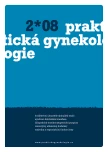The influence of morbid obesity as an independent risk factor of termination of pregnancy by caesarean section
Authors:
J. Šula
Authors‘ workplace:
LF MU a FN Brno
; Gynekologicko-porodnická klinika
Published in:
Prakt Gyn 2008; 12(2): 117-120
Overview
The authors examine the influence of morbid obesity at the beginning of pregnancy as an independent risk factor for delivery by caesarean section. A total of 2,231 pregnant patients aged 16 to 37 were included in our study. The patients were divided into 4 groups according to their Body Mass Index at the beginning of pregnancy. The authors obtained evidence that morbid obesity is an independent risk factor for delivery by caesarean section. A higher BMI at the beginning of pregnancy signifi cantly increases the probability of the pregnancy ending by caesarean section. The risk of the pregnancy ending by caesarean section is three times higher in pathologically obese women than in women with normal weight.
Key words:
pregnancy – delivery – caesarean section – fatty pelvis – overweight
Sources
1. Wang JX, Davies M, Norman RJ. Body mass and probability of pregnancy during assisted reproduction treatment: retrospective study. BMJ 2000; 321: 1320–1321.
2. Hudecek R, Ventruba P, Crha I et al. Analysis of factors affecting the results of assisted reproduction using a system for information mining of the SHLUK database Ceska Gynekol 2001; 66 (4): 270–276.
3. Hrazdilova O, Unzeitig V, Janku P et al. Relationship of age and the body mass index to selected hypertensive complications in pregnancy. Int J Gynaecol Obstet 2001; 75 (2): 165–169.
4. World Health Organization. Technical report series 894: „Obesity: preventing and managing the global epidemic.“ Geneva: World Health Organization 2000.
5. Sheiner E, Levy A, Menes TS et al. Maternal obesity as an inependent risk factor for caesarean delivery. Paediatr Perinat Epidemiol 2004; 18 (3): 196–201.
6. Compton AA. Soft tissue and pelvic dystocia. Clin Obstet Gynecol 1987; 30 (1): 69–76
7. Wischnik A, Lehmann KJ, Ziegler M et al. Does the fatty pelvis exist? Quantitative computer tomography studies. Z Geburtshilfe Perinatol 1992; 196 (6): 247–252.
8. Roztočil A. Nepravidelné polohy a držení plodu. In: Zwinger A et al. Porodnictví. Praha: Galén 2004: 292.
9. Buhimschi S, Buhimschi IA, Malinow AM et al. Intrauterine pressure during the second stage of labor in obese women. Obstet Gynecol 2004; 103 (2) : 225-230.
Labels
Paediatric gynaecology Gynaecology and obstetrics Reproduction medicineArticle was published in
Practical Gynecology

2008 Issue 2
Most read in this issue
- Twin-to-twin transfusion syndrome
- The influence of morbid obesity as an independent risk factor of termination of pregnancy by caesarean section
- Prevention of Rh (D) alloimmunization in Rh (D) negative women
- Idiopathic thrombocytopenic purpura in pregnancy
